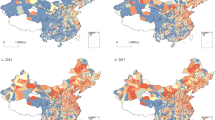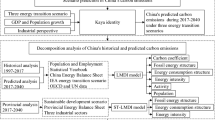Abstract
With less than ten years left to meet its pledge to peak carbon dioxide emissions (peak emissions hereafter) by 2030, China has entered a critical emissions reduction stage. How to meet this commitment in a context in which GDP per capita will double from 2020 by 2035 is a major decision-making issue for the Chinese government and people and one which warrants further study. To reveal the relationships between the GDP growth rate, the rate of decrease of carbon intensity and the time to reach peak emissions, this study translates the question as to “when China’s carbon emissions peak will occur” into “how can one control the rate of carbon intensity decrease at a given GDP growth rate”. In the light of the results of a random forest algorithm used to identify and project the key drivers of carbon intensity in China, a mathematical model was developed to simulate different scenarios relating to decreases in carbon intensity. The date at which Chinese carbon emissions will peak is predicted by comparing the rate of decrease of carbon intensity with the GDP growth rate. The results show that the time to peak emissions depends on the relationship between the rate of decrease of carbon intensity and the GDP growth rate, where the former depends mainly on the energy structure and policy. If China’s annual GDP growth rate were 5.0% during the 15th Five-Year Plan, and if the share of non-fossil energy in total energy consumption were 23.0% or above, China’s carbon emissions will peak before 2030. If the share of non-fossil fuels were 20.0% or less, China might not be able to reach its 2030 target. In this latter case an acceleration in the pace of energy restructuring would be required to reach peak emissions before 2030. The projected peak emissions scenarios suggest that the carbon peak will occur between 2025 to 2029, with average peak emissions of 11.2 billion tons and a distribution ranging from a minimum of 10.5 billion and a maximum of 11.9 billion tons. If the GDP growth rate were 4.5%, 5.5% or 6.0% during the 15th Five-year Plan, the share of non-fossil energy must reach 23.0%, 25.0% or 27.0%, respectively, to ensure that emissions peak by 2030. The results of this study provide a series of reference points for China’s pursuit of feasible pathways to peak carbon emissions by 2030.
Similar content being viewed by others
References
An Q, Pang J, Feng X Z. 2021. Policy recommendations for China to achieve carbon peak: Multi scenario simulation analysis based on carbon pricing model (in Chinese). Environ Sustainable Dev, 46: 58–70
Bi C. 2015. Scheme and policies for peaking energy carbon emissions in China (in Chinese). China Popul Res Environ, 25: 20–27
Chai Q M, Xu H Q. 2015. Modeling carbon emission peaking pathways in China based on integrated assessment model IAMC (in Chinese). China Popul Res Environ, 25: 37–46
Chai Q M, Xu H Q. 2014. Modeling an emissions peak in China around 2030: Synergies or trade-offs between economy, energy and climate security. Adv Clim Change Res, 5: 169–180
Du Q, Chen Q, Lu N. 2012. Forecast of China’s carbon emissions based on modified IPAT model (in Chinese). Acta Sci Circumstant, 32: 2294–2302
Duan H, Zhou S, Jiang K, Bertram C, Harmsen M, Kriegler E, van Vuuren D P, Wang S, Fujimori S, Tavoni M, Ming X, Keramidas K, Iyer G, Edmonds J. 2021. Assessing China’s efforts to pursue the 1.5°C warming limit. Science, 372: 378–385
Elzen M, Fekete H, Höhne N, Admiraal A, Forsell N, Hof A F, Olivier J G J, Roelfsema M, van Soest H. 2016. Greenhouse gas emissions from current and enhanced policies of China until 2030: Can emissions peak before 2030? Energy Policy, 89: 224–236
Farifteh J, van der Meer F, Atzberger C, Carranza E J M. 2007. Quantitative analysis of salt-affected soil reflectance spectra: A comparison of two adaptive methods (PLSR and ANN). Remote Sens Environ, 110: 59–78
Feng Z X, Wang A J. 2016. Comparative study of China regional carbon peak: Based on national data and Shaanxi province (in Chinese). J Xi’an Jiaotong Univ-Soc Sci, 36: 96–104
Fu J F, Liu X M. 2010. A framework for China’s low carbon economy on the basis of scenario analysis and discussion on relevant issues (in Chinese). Resour Sci, 32: 205–210
Green F, Stern N. 2017. China’s changing economy: Implications for its carbon dioxide emissions. Clim Policy, 17: 423–442
Gu G C, Wang Z. 2017. A simulation of China’s carbon governance under industrial restructuring by investment control (in Chinese). Geogr Res, 36: 2225–2238
Guo J K. 2015. Histories of G7’s and China’s carbon emissions policies and a forecast of China’s peak emissions (in Chinese). Sino-Glob Energy, 20: 1–6
He J K. 2014. An analysis of China’s CO2 emission peaking target and pathways. Adv Clim Change Res, 5: 155–161
He. 2013. Analysis of CO2 emissions peak: China’s objective and strategy (in Chinese). China Popul Res Environ, 23: 1–9
Jiang K J, He C M, Zhuang X, Liu J, Gao J, Xu X Y, Chen S. 2016. Scenario and feasibility study for peaking CO2 emissions from energy activities in China (in Chinese). Clim Change Res, 12: 167–171
Li H M, Qi Y. 2011. Comparison on China’s carbon emission scenarios in 2050 (in Chinese). Adv Clim Change Res, 7: 271–280
Li J F, Ma Z Y, Zhang Y X, Wen Z C. 2018. Analysis on energy demand and CO2 emissions in China following the Energy Production and Consumption Revolution Strategy and China Dream target. Adv Clim Change Res, 9: 16–26
Lin B Q, Jiang Z J. 2009. Environmental kuznets curve prediction of carbon dioxide in China and influencing factor analysis (in Chinese). Manage World, (4): 27–36
Lin B Q, Li J L. 2015. Transformation of China’s energy structure under environmental governance constraints: A peak value analysis of coal and carbon dioxide (in Chinese). Soc Sci China, (9): 84–107
Lin J, Kang J, Khanna N, Shi L, Zhao X, Liao J. 2018. Scenario analysis of urban GHG peak and mitigation co-benefits: A case study of Xiamen City, China. J Cleaner Product, 171: 972–983
Liu B L, Chen S Y, Guo Q W, Lin B Q, Zhang Y B, Qi Y F, Wang J, Xu X X, Cai Y Z, Yang X M, Pan S Y, Shi Y P, Chen D H, Fang H L, Li L M, Wang W T, Zhang X Y, Yan C L. 2019. Growth driver transformation and high-quality development (in Chinese). Econ Perspect, (6): 63–72
Liu L, Zong H, Zhao E, Chen C, Wang J. 2014. Can China realize its carbon emission reduction goal in 2020: From the perspective of thermal power development. Appl Energy, 124: 199–212
Liu W D, Tang Z P, Xia Y, Han M Y. 2019. Identifying the key factors influencing Chinese carbon intensity using machine learning, the random forest algorithm, and evolutionary analysis (in Chinese). Acta Geogr Sin, 74: 2592–2603
Liu Y, Cai S F, Zhang Q Z. 2014. The economic impact of China’s carbon dioxide emissions to peak in 2025, 2030 and 2040: Based on the dynamic GTAP-E model (in Chinese). Manage Rev, 26: 3–9
Liu Z, Guan D B, Wei W. 2018. Carbon emission accounting in China (in Chinese). Sci Sin Terr, 48: 878–887
Liu Z, Meng J, Deng Z, Lu P, Guan D, Zhang Q, He K, Gong P. 2020. Embodied carbon emissions in China-US trade. Sci China Earth Sci, 63: 1577–1586
Ma D, Chen W Y. 2016. Analysis of China’s 2030 carbon emission peak level and peak path (in Chinese). China Popul Res Environ, 26: 1–4
Mi Z, Wei Y M, Wang B, Meng J, Liu Z, Shan Y, Liu J, Guan D. 2017. Socioeconomic impact assessment of China’s CO2 emissions peak prior to 2030. J Cleaner Product, 142: 2227–2236
Mo J L, Duan H B, Fan Y, Wang S Y. 2018. China’s energy and climate targets in the Paris Agreement: Integrated assessment and policy options (in Chinese). Econ Res J, 53: 168–181
Niu S, Liu Y, Ding Y, Qu W. 2016. China’s energy systems transformation and emissions peak. Renew Sust Energy Rev, 58: 782–795
Pao H T, Tsai C M. 2010. CO2 emissions, energy consumption and economic growth in BRIC countries. Energy Policy, 38: 7850–7860
Qu S N, Guo C X. 2010. Forecast of China’s carbon emissions based on STIRPAT model (in Chinese). China Popul Res Environ, 20: 10–15
Research group on implementation paths for China’s reaching the peak in CO2 emissions as soon as possible. 2018. Earliest Peaking the Carbon Emission of China (in Chinese). Beijing: Economic Press China
Su Y, Liu X, Ji J, Ma X. 2021. Role of economic structural change in the peaking of China’s CO2 emissions: An input-output optimization model. Sci Total Environ, 761: 143306
Tollefson J. 2016. China’s carbon emissions could peak sooner than forecast. Nature, 531: 425
Wang H W. 1999. Partial Least Squares Regression Method and Applications (in Chinese). Beijing: National Defense Industry Press
Wang K, Shao H Q, Zhou T T, Liu H L. 2017. Analysis of impact factors of CO2 emissions from tourism in China based on STIRPAT model (in Chinese). Acta Sci Circumstant, 37: 1185–1192
Wang X, Zhang S. 2017. Exploring linkages among China’s 2030 climate targets. Clim Policy, 17: 458–469
Wang Y, Wang E D, Bi Y. 2017. Impact of a peak in carbon emissions on China’s economy in different situations: Analysis based on CGE model (in Chinese). Resour Sci, 39: 1896–1908
Wang Y, Wang Y. 2019. Feasibility and optimal pathway of China’s double targets for carbon reduction: The perspective of energy structure optimization (in Chinese). China Environ Sci, 39: 4444–4455
Wang Z, Zhu Y, Zhu Y, Shi Y. 2016. Energy structure change and carbon emission trends in China. Energy, 115: 369–377
Wu L J, Tian Q B. 2016. Study on time trend and regional difference of carbon emission in China: From the perspective of carbon emission evolution law in industrialization (in Chinese). J Shanxi Univ Finance Econ, 38: 25–35
Xu G, Schwarz P, Yang H. 2020. Adjusting energy consumption structure to achieve China’s CO2 emissions peak. Renew Sust Energy Rev, 122: 109737
Yuan J, Xu Y, Hu Z, Zhao C, Xiong M, Guo J. 2014. Peak energy consumption and CO2 emissions in China. Energy Policy, 68: 508–523
Zhang L, Li Y A, Liu X L. 2020. Research on energy consumption prediction of civil buildings based on grey relational analysis (in Chinese). Archit Technol, 51: 1129–1134
Zhang X, Karplus V J, Qi T, Zhang D, He J. 2016. Carbon emissions in China: How far can new efforts bend the curve? Energy Econ, 54: 388–395
Zhou N, Fridley D, Khanna N Z, Ke J, McNeil M, Levine M. 2013. China’s energy and emissions outlook to 2050: Perspectives from bottom-up energy end-use model. Energy Policy, 53: 51–62
Zhou N, Price L, Yande D, Creyts J, Khanna N, Fridley D, Lu H, Feng W, Liu X, Hasanbeigi A, Tian Z, Yang H, Bai Q, Zhu Y, Xiong H, Zhang J, Chrisman K, Agenbroad J, Ke Y, McIntosh R, Mullaney D, Stranger C, Wanless E, Wetzel D, Yee C, Franconi E. 2019. A roadmap for China to peak carbon dioxide emissions and achieve a 20% share of non-fossil fuels in primary energy by 2030. Appl Energy, 239: 793–819
Acknowledgements
This work was supported by the National Key R&D Program of China (Grant No. 2016YFA0602804).
Author information
Authors and Affiliations
Corresponding author
Rights and permissions
About this article
Cite this article
Liu, W., Jiang, W., Tang, Z. et al. Pathways to peak carbon emissions in China by 2030: An analysis in relation to the economic growth rate. Sci. China Earth Sci. 65, 1057–1072 (2022). https://doi.org/10.1007/s11430-021-9901-y
Received:
Revised:
Accepted:
Published:
Issue Date:
DOI: https://doi.org/10.1007/s11430-021-9901-y




